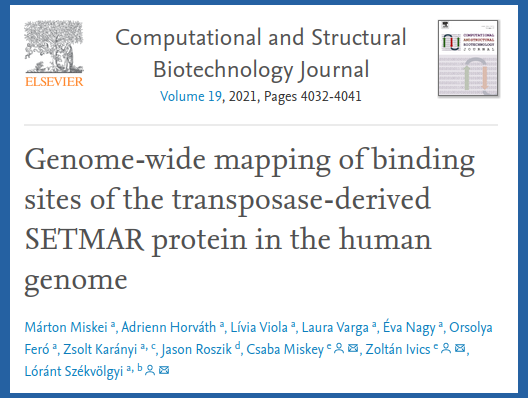Category: News
New publication in CSBJ
New article has been published in Computational and Structural Biotechnology Journal:
Genome-wide mapping of binding sites of the transposase-derived SETMAR protein in the human genome
Márton Miskei, Adrienn Horváth, Lívia Viola, Laura Varga, Éva Nagy, Orsolya Feró, Zsolt Karányi, Jason Roszik, Csaba Miskey, Zoltán Ivics, Lóránt Székvölgyi
Abstract. Throughout evolution, DNA transposons provide a recurrent supply of genetic information to give rise to novel gene functions by fusion of their transposase domain to various domains of host-encoded proteins. One of these “domesticated”, transposase-derived factors is SETMAR/Metnase which is a naturally occurring fusion protein that consists of a histone-lysine methyltransferase domain and an HsMar1 transposase. To elucidate the biological role of SETMAR, it is crucial to identify genomic targets to which SETMAR specifically binds and link these sites to the regulation of gene expression. Herein, we mapped the genomic landscape of SETMAR binding in a near-haploid human leukemia cell line (HAP1) in order to identify on-target and off-target binding sites at high resolution and to elucidate their role in terms of gene expression. Our analysis revealed a perfect correlation between SETMAR and inverted terminal repeats (ITRs) of HsMar1 transposon remnants, which are considered as natural target sites for SETMAR binding. However, we did not detect any untargeted events at non-ITR sequences, calling into question previously proposed off-target binding sites. We identified sequence fidelity of the ITR motif as a key factor for determining the binding affinity of SETMAR for chromosomes, as higher conservation of ITR sequences resulted in increased affinity for chromatin and stronger repression of SETMAR-bound gene loci. These associations highlight how SETMAR’s chromatin binding fine-tune gene regulatory networks in human tumour cells.
Danube Epigenetics Webinar Series
DANUBE EPIGENETICS WEBINAR SERIES
The Danube Conference on Epigenetics was cancelled due to the COVID -19 pandemics. The organizers decided to launch the Danube Epigenetics Webinar Series with the original invited speakers of the conference. The webinars will take place every other week on Thursday at 3:30 pm CET. The series starts on Thursday October 8.
Lectures will be followed by Q&A and a virtual coffee break session.
Registration for the webinar is FREE for everyone.
New publication in Oncotarget
New article has been published in Oncotarget:
The targeted LHRH analog AEZS-108 alters expression of genes related to angiogenesis and development of metastasis in uveal melanoma
Klára Fodor, Nikoletta Dobos, Andrew Schally, Zita Steiber, Gábor Oláh, Éva Sipos, Lóránt Székvölgyi
Abstract. Uveal melanoma (UM) is the most common malignant tumor of the eye. Recently, we have established that 46% of UM specimens express LHRH receptors. This finding supports the idea of a LHRH receptor-targeted therapy of UM patients. Cytotoxic analog of LHRH, AEZS-108 exhibits effective anti-cancer activity in LHRH-receptor positive cancers. AEZS-108 is a hybrid molecule, composed of a synthetic peptide carrier and the cytotoxic doxorubicin (DOX). In the present study, we investigated AEZS-108 induced cytotoxicity and the altered mRNA expression profile of regulatory factors related to angiogenesis and metastasis in LHRH receptor positive OCM3 cells. Our results show that AEZS-108 upregulates the expression of MASPIN/SERPINB5 tumor suppressor gene, which is downregulated in normal uvea and UM specimens independently from the LHRH receptor-ligand interaction. AEZS-108 also substantially downregulates hypoxia-inducible factor 1 alpha (HIF1A) expression. In order to investigate the mechanism of the induction of MASPIN by AEZS-108, OCM3 cells were treated with free DOX, D-Lys6 LHRH analog, or AEZS-108. qRT- PCR analysis revealed in OCM3 cells that AEZS-108 is a more potent inducer of MASPIN than free DOX. In conclusion, we show for the first time that AEZS-108 has a major impact in the regulation of angiogenesis thus plays a potential role in tumor suppression. Taken together, our results support the development of novel therapeutic strategies for UM focusing on LHRH receptors.
New publication in Frontiers in Cell and Dev. Biol.
New article has been published in Frontiers in Cell and Dev. Biol.:
Histone H3 lysine 56 acetylation is required for formation of normal levels of meiotic DNA breaks in S. cerevisiae
Zsolt Karányi, Lilla Hornyák, Lóránt Székvölgyi
Abstract. Meiotic recombination is initiated by Spo11-catalyzed DNA double-strand breaks (DSBs) that are promoted by histone modifications and histone modifying enzymes. Herein we investigated the role of histone H3 lysine 56 acetylation (H3K56ac) located near the entry/exit points of the DNA in the globular H3 domain. We generated a series of mutant cells (asf1Δ, rtt109Δ, hst3/4Δ, and H3K56A) in which the endogenous level of H3K56ac was manipulated and tracked during meiotic growth. We show that complete loss or increased abundance of H3K56ac in these mutants allows timely entry into meiosis and sporulation and does not impair S phase progression, first and second meiotic cell divisions, and spore viability. In the asf1Δ, rtt109Δ, hst3/4Δ mutants, DSBs and crossovers form normal levels with a short (60-min) delay at the HIS4-LEU2 artificial recombination hotspot, however, DSB formation shows a ∼threefold decrease in the H3K56A mutant at the natural BUD23-ARE1 hotspot. The latter DSB phenotype, showing significant DSB reduction in the H3K56A mutant, was also observed at DSB sites using genome-wide mapping of Rfa1-coated single-stranded DNA flanking DSBs (RPA ChIP). Parallel mapping of H3K56-acetylated histones in wild type cells revealed strong depletion of the H3K56ac ChIP signal over Spo11-oligo DSBs, albeit most H3K56-acetylated histones were enriched adjacent to the identified RPA ChIP binding sites. Taken together, these associations demonstrate a prominent role of H3 lysine 56 acetylation in the formation of DNA breaks within recombination hotspot regions.
New publication in DNA Repair
New article has been published in DNA Repair:
Drugging the R-loop interactome: RNA-DNA hybrid binding proteins as targets for cancer therapy
Beáta Boros-Oláh, Nikoletta Dobos, Lilla Hornyák, Zoltán Szabó, Zsolt Karányi, Gábor Halmos, Jason Roszik, Lóránt Székvölgyi
Abstract. Unravelling the origin of genetic alterations from point mutations to chromosomal rearrangements was greatly enhanced by the discovery of RNA-DNA hybrids (R-loops) that behave as hotspots of genomic instability in a variety of organisms. Current models suggest that uncontrolled R-loops are a hazard to genome integrity, therefore, identifying proteins that are involved in recognising and signalling R-loop structures are of key importance. Herein we analysed key RNA-DNA hybrid binding proteins in humans taking advantage of large-scale gene expression, survival rate, and drug-sensitivity data from cancer genomics databases. We show that expression of RNA-DNA hybrid binding proteins in various cancer types is associated with survival and may have contrasting outcomes in responding to therapeutic treatments. Based on the revealed pharmacogenomic landscape of human RNA-DNA hybrid binding proteins, we propose that R-loops and R-loop binding proteins are potentially relevant new epigenetic markers and therapeutic targets in multiple cancers.


 D5 Creation
D5 Creation